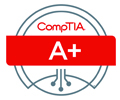
CompTIA A+ Certification Training (TIA101)
Course Length: 5 days
Delivery Methods:
Available as private class only
Course Overview

This CompTIA A+ training class is for individuals preparing for a career as an entry-level IT professional or computer service technician. You will learn to install, configure, optimize, troubleshoot, repair, upgrade, and perform preventive maintenance on PCs, digital devices, and operating systems. This course will help you prepare for the CompTIA A+ certification examinations. Contact us to schedule group training or enroll today in our next public live online training session.
Course Benefits
- Install and configure PC system unit components and peripheral devices.
- Install, configure, and troubleshoot display and multimedia devices.
- Install, configure, and troubleshoot storage devices.
- Install, configure, and troubleshoot internal system components.
- Explain network infrastructure concepts.
- Configure and troubleshoot network connections.
- Implement client virtualization.
- Support and troubleshoot laptops.
- Support and troubleshoot mobile devices.
- Support and troubleshoot print devices.
- Support operating systems.
- Install, configure, and maintain operating systems.
- Maintain and troubleshoot Microsoft Windows.
- Configure and troubleshoot network connections.
- Manage users, workstations, and shared resources.
- Implement physical security.
- Secure workstations and data.
- Troubleshoot workstation security issues.
- Support and troubleshoot mobile operating systems and applications.
- Implement operational procedures.
Course Outline
- Windows Operating System Compatibilities and Features
- Idenitify Common Operating Systems
- Troubleshooting Methodology
- Use Windows Features and Tools
- Manage Files in Windows
- Manage Disks in Windows
- Manage Devices in Windows
- Installing and Configuring PC Components
- Use Appropriate Safety Procedures
- PC Components
- Common Connection Interfaces
- Install Peripheral Devices
- Installing, Configuring, and Troubleshooting Display and Multimedia Devices
- Install and Configure Display Devices
- Trouble shooting Display Devices
- Install and Configure Multimedia Devices
- Installing, Configuring, and Troubleshooting Storage Devices
- Install System Memory
- Install and Configure Mass Storage Devices
- Install and Configure Removable Storage
- Configure RAID
- Troubleshoot Storage Devices
- Installing, Configuring, and Troubleshooting Internal System Components
- Install and Upgrade CPUs
- Configure and Update BIOS/EUFI
- Install Power Supplies
- Troubleshoot Internal System Components
- Configure a Custom PC
- Installing, Configuring, and Maintaining Operating Systems
- Configure and Use Linux
- Configure and Use macOS
- Install and Upgrade Operating Systems
- Maintain OSs
- Maintaining and Troubleshooting Microsoft Windows
- Install and Manage Windows Applications
- Manage Windows Performance
- Troubleshoot Windows
- Network Infrastructure Concepts
- Wire Networks
- Network Hardware Devices
- Wireless Networks
- Internet Connection Types
- Network Configuration Concepts
- Network Services
- Configuring and Troubleshooting Networks
- Configure Network Connection Settings
- Install and Configure SOHO Networks
- Configure SOHO Network Security
- Configure Remote Access
- Troubleshoot Network Connections
- Install and Configure IoT Devices
- Managing Users, Workstations, and Shared Resources
- Manage Users
- Configure Shared Resources
- Configure Active Directory Accounts and Policies
- Implementing Client Virtualization and Cloud Computing
- Configure Client-Side Virtualization
- Cloud Computing Concepts
- Security Concepts
- Logical Security Concepts
- Threats and Vulnerabilities
- Physical Security Measures
- Securing Workstations and Data
- Implement Security Best Practices
- Implement Data Protection Policies
- Protect Data During Incident Response
- Troubleshooting Workstation Security Issues
- Detect, Remove, and Prevent Malware
- Troubleshoot Common Workstation Security Issues
- Supporting and Troubleshooting Laptops
- Use Laptop Features
- Install and Configure Laptop Hardware
- Troubleshoot Common Laptop Issues
- Supporting and Troubleshooting Mobile Devices
- Mobile Device Types
- Connect and Configure Mobile Device Accessories
- Configure Mobile Device Network Connectivity
- Support Mobile Apps
- Secure Mobile Devices
- Troubleshoot Mobile Device Issues
- Installing, Configuring, and Troubleshooting Print Devices
- Maintain Laser Printers
- Maintain Inkjet Printers
- Maintain Impact, Thermal, and 3D Printers
- Install and Configure Printers
- Troubleshoot Print Device Issues
- Install and Configure Imaging Devices
- Implementing Operational Procedures
- Environmental Impacts and Controls
- Create and Maintain Documentation
- Use Basic Change Management Best Practices
- Implement Disaster Prevention and Recovery Methods
- Basic Scripting Concepts
- Professionalism and Communication
Class Materials
Each student will receive a comprehensive set of materials, including course notes and all the class examples.
Class Prerequisites
Experience in the following is required for this CompTIA class:
- End-user skills with Windows-based personal computers, including the ability to: browse and search for information on the Internet; start up, shut down, and log on to a computer and network; run programs; and move, copy, delete, and rename files in Windows Explorer.
- Basic knowledge of computing concepts, including the difference between hardware and software; the functions of software components, such as the operating system, applications, and file systems; and the function of a computer network.
Live Private Class
- Private Class for your Team
- Live training
- Online or On-location
- Customizable
- Expert Instructors